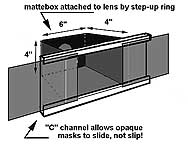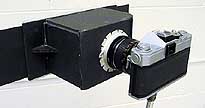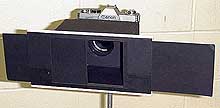The "simplest" special effect - matte box photography!
Andrew Davidhazy
Imaging and Photographic Technology
School of Photographic Arts and Sciences
Rochester Institute of Technology
In general we assume that photographs are truthful representations of
reality. This is a characteristic of photography that has been associated
with it since its invention. One of the factors that supports this
perception of photographs as witnesses of time is the shuttering mechanism
of cameras and the nomenclature associated with its operation. The letter
"I" was stamped next to the shutter release lever on many early cameras.
This was understood to stand for "instantaneous" and by implication
suggested that the camera would capture an instantaneous "slice of time"
and that this would result in a "snapshot" view of the scene.
That the general public perceives photographs in this manner has colored
our perception regarding photographs. Our very strong belief in the view
that photographs are instantaneous records of time eventually makes
possible waht we call special effects, falsifications and, in today's
digital world, post-exposure image manipulation procedures that truly
jeopardize the perceived truthfulness of photographic records.
Don't worry though, most of society still believes that family snapshots
are truthful records and when sharing travel photographs with friends and
family hardly nobody questions the truthfulness of the photographs
displayed by a traveler showing photographs of sights seen and events
experienced in far off lands and exotic locations.
Deception through the photographic medium is, however, nothing new. It is
almost as old as photography itself and one of the simplest methods of
making a startling photographic record is to recognize some validity to
the premise and statements mentioned above and purposefully making a
photograph of a scene in a sequential, piecemeal, manner instead of an
instantaneous one. These sequentially-made images are then viewed by an audience
instantaneously. As you are viewing the photograph on the right right now.
 Because of this discrepancy between the production step
and the perceptual experience the audience tends to be amazed and/or
confused when viewing the final product, a "special effect". Several
techniques exploit this concept. In this case we are concerned with what
is called a "matte box".
Because of this discrepancy between the production step
and the perceptual experience the audience tends to be amazed and/or
confused when viewing the final product, a "special effect". Several
techniques exploit this concept. In this case we are concerned with what
is called a "matte box".
Matte boxes in photography are devices that exploit the possibilities of
making a negative by exposing its various parts at different times and
under different conditions. Matte boxes are generally used at the
photography stage although a variation of the approach can be used at the
printing stage. Matte-boxes are devices placed in front of the camera
lens.
The basic idea behind matte box photography is that if a dark,
featureless, subject is placed in front of a camera, the film will receive
no exposure where the image of this subject is located. If, without
moving the film, another exposure is made of a similar dark subject but
one such that it is the exact opposite of the first one in terms of area
that it covers, then the second exposure will seamlessly blend into the
areas that were unexposed by the first exposure. These obstructions placed
in front of the camera lens are called masks. One mask is called a
positive mask, the other a negative mask.
The simplest example of how one might use such a set of masks is the
making of a photograph where one individual appears in two or more
locations in the same scene. This is what will be described below.
One can make a "matte-box" out of a rigid lens shade and then sequentially
covering one side during the first exposure, and then the other, for the
second exposure, with some black photographic tape. Commercial matte boxes
are also available and "compendium shades" sold by several manufacturers
can also be adapted to perform as such. Or, one can make one's own
matte-box following the directions given below and shown in the accompanying
illustrations.
 The box is made out of black, 1/4 inch foam core board. This is a very good
material to use because it is rigid and easy to cut and glue. The building
process starts out with making a rectangular "tube" with walls about 4 inches
or so deep. This is fashioned easily from an 18 strip of foam core 4 inches wide
with cuts at 4, 10, 14 inches that do not extend all the way through but which
allow the board to bent at sharp right angles. The free edges are glued
together so the fourth edge resembles the other three formed by bending.
The box is made out of black, 1/4 inch foam core board. This is a very good
material to use because it is rigid and easy to cut and glue. The building
process starts out with making a rectangular "tube" with walls about 4 inches
or so deep. This is fashioned easily from an 18 strip of foam core 4 inches wide
with cuts at 4, 10, 14 inches that do not extend all the way through but which
allow the board to bent at sharp right angles. The free edges are glued
together so the fourth edge resembles the other three formed by bending.
At the rear of the tube is glued a rectangular cover into which a circular
opening is cut in the center, somewhat smaller in diameter than the outside diameter of a
metal step-up ring that is attached to the outside of the back wall of the
tube with tape. The step-up ring should be a generous one in terms of being
bigger than the filter thread size of the camera.
The step-up ring can also be press fitted (not advisable) or glued. Good
thing about taping it is that the matte-box can be detached from the ring in
case this might be needed to align the box for special orientations or for
other lenses that the box was originally designed for and which might have a
different filter thread orientation.
The "front" end of the tube is fitted with a "C" channel made of foamcore on
the box side and stiff, black, cardboard on the other side. The foamcore board
about 5 by 10 inches in size, has an opening cut into it about the size of the
front of the box or 4x6 inches. Two guiderails, about 1/4 by 10 inches wide,made of
the same black cardboard that will be used for the "side masks" are glued to
the top and bottom edges of this front cover. Then a very thin piece of paper
is glued on top of these rails and a front piece about 1/2 by 10 inches is
glued on top of the thinner pieces. This essentially makes a channel,
resembling the figure "C", into which a couple of black masks, about 4 1/2
inches by 8 inches or so, can be slid in, one from each side as shown in the
illustrations.
This "C" channel is glued to the front end of the matte box and the finished product might look something like this:


Including an image of one person in two places on a negative can be done is
several ways and an easy way to do this is to photograph the person against a
black background using either multiple exposures with the camera shutter or
keeping the shutter open for a time and then operating a flash twice (or more)
while the shutter is open. This results in two or more images of a subject on
the same piece of film but the background is not very "interesting".
On the other hand, the use of a matte box allows a single person to be
included in a photograph against a normal background. This is what ultimately
makes the photograph more believable, or unbelievable, as the case may be.
When a location for your photograph has been identified, the camera is
placed on a sturdy tripod and your subject placed on one side of the scene.
It is easy to see that if both black masks of the matte box are inserted in
the channel so that they touch in the middle of the front opening of the box
and an exposure is made, no image will be recorded.
Now the
mask corresponding to that side of the scene where the subject is located is pulled away from the front
opening of the box and in the viewfinder of the camera the side where the
subject is located will be seen. The other side will be dark. In the middle of
the frame there will be a line, gradually going from clear to dark. The degree
of sharpness of this edge is a function of the lens aperture, focal length and
distance the lens is focused on. It is advisable to preview the location of the
edge of the mask using the camera lens in the stop-down mode instead of leaving
the lens wide open. With the lens wide open the edge may be very soft and in
some cases will be hard to see its location clearly.
 Then the first exposure is made and the shutter is recocked. It is easiest to use
cameras that have multiple exposure capability such as some SLR's or large
format view cameras.
Then the first exposure is made and the shutter is recocked. It is easiest to use
cameras that have multiple exposure capability such as some SLR's or large
format view cameras.
The mask that uncovered the scene is now gently pushed over so that it again
touches the edge of the other mask and then that mask is pulled back,
revealing the scene on the other side of the viewfinder. Your subject now takes
up a position in that area and your second exposure is now made.
Because the dark edge in the second photograph is exactly the opposite in
sense to that of the first the exposure along the central seam will perfectly
even out and the result will be a uniform exposure across the negative. The
results should be much better than what can be accomplished with a computer
by cutting a figure
out of one photograph and pasting that figure into another one already
containing a record of a given subject. In the matte box photograph the
lighting, the perspective, the edges and other factors will be automatically
recorded properly. It is very difficult to do this correctly with a computer.
Besides, a matte box is much cheaper.
In all fairness, if one were to simply take two or more photographs of a
subject in different parts of a scene, digitize the images and then cut the
pictures and paste the backgrounds (carrying the figure in different
locations) together, rather than trying to cut out a person's figure and
repositioning it in different places, the computer assembled result would
outstrip what can be done with a matte box. On the other hand a matte box is
still cheaper than a computer, the software necessary or the making of output
materials such as film negatives or "digital" prints.
Some parting thoughts on this process: problems that photographers do need to
consider include the fact that there must be no movement across the delimiting
boundaries of the "masks", the camera must remain locked in position and the
film must remain stationary between the two (or more) exposures. Of course this
is only if technical perfection is sought. For creative applications other "rules"
apply.
The matte box also allows photographers to combine two or more different,
unrelated, scenes together on one piece of film by using two or more masks
that are complements of each other placed sequentially in front of the
camera. The outline of the mask edge sometimes becomes visible when this
process is practiced but when used successfully this can be made to actually
contribute to the final product's visual appeal.
By the way, if you want to read about a variation of the matte box and see
what a slit-scan matte box can do in terms of producing unusual depictions of
our "instantaneous" world go to an article entitled Slit Scan
Photography.
If you'd like to communicate with me about this topic simply send me e-mail
by clicking HERE!.
This page has been visited
 times since
August 24, 1996
times since
August 24, 1996
The counter read 5 on April 3, 2000
 Because of this discrepancy between the production step
and the perceptual experience the audience tends to be amazed and/or
confused when viewing the final product, a "special effect". Several
techniques exploit this concept. In this case we are concerned with what
is called a "matte box".
Because of this discrepancy between the production step
and the perceptual experience the audience tends to be amazed and/or
confused when viewing the final product, a "special effect". Several
techniques exploit this concept. In this case we are concerned with what
is called a "matte box".



